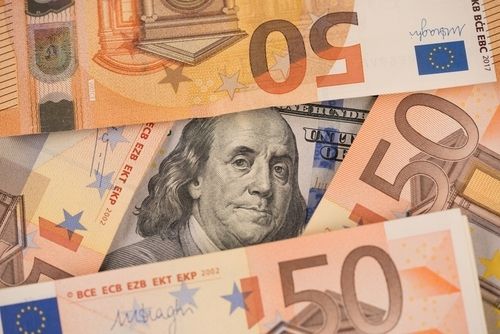EUR/USD trades with mild losses near 1.0300 as traders await US NFP release
- Gold remains bid as lack of Fed clarity and geopolitical frictions persist
- Gold Price Forecast: XAU/USD drifts higher above $4,200 as Fed delivers expected cut
- Gold Price Steady Climb and the Sudden Surge of Silver and Copper: Will Their Bull Run Extend Into 2026?
- Gold Price Forecast: XAU/USD climbs above $4,250 as Fed rate cut weakens US Dollar
- Silver Price Forecast: XAG/USD refreshes record high, looks to build on move beyond $61.00
- Fed Cuts Rates: Bitcoin Rallies Then Retreats - Bear Market Ahead?

EUR/USD softens to around 1.0300 in Friday’s Asian session.
Several Fed officials favour slowing the pace of interest-rate cuts.
Eurozone Retail Sales showed tepid growth in November.
The EUR/USD pair trades with a mild negative bias around 1.0300 during the Asian trading hours on Friday. The Federal Reserve’s (Fed) move to delay the interest rate cut continues to lift the Greenback and exert some selling pressure on the major pair. Traders brace for the US December Nonfarm Payrolls (NFP) report, which is due later on Friday.
Several Fed officials signalled rate cut caution, citing elevated inflation and the uncertainty under the incoming Donald Trump administration. Fed Bank of Boston President Susan Collins said on Thursday that significant uncertainty over the outlook calls for the US central bank to move forward cautiously with future rate reduction.
Meanwhile, Fed Governor Michelle Bowman noted that she sees the interest rates on hold for the time being until the data shows inflation has resumed its downward trend. The hawkish comments from the Fed policymakers could underpin the US Dollar (USD) against the Euro (EUR) in the near term.
Across the pond, the Eurozone Retail Sales figures fail to boost the shared currency ahead of Friday’s US key employment data. Data released by Eurostat on Thursday showed that Retail Sales increased 1.2% YoY in November after rising by a revised 2.1% in October.
However, the Eurozone preliminary Harmonized Index of Consumer Prices (HICP) data for December has pushed back expectations that the European Central Bank (ECB) will deliver a jumbo rate cut. This, in turn, might help limit the EUR’s losses for the time being.
Euro FAQs
The Euro is the currency for the 19 European Union countries that belong to the Eurozone. It is the second most heavily traded currency in the world behind the US Dollar. In 2022, it accounted for 31% of all foreign exchange transactions, with an average daily turnover of over $2.2 trillion a day. EUR/USD is the most heavily traded currency pair in the world, accounting for an estimated 30% off all transactions, followed by EUR/JPY (4%), EUR/GBP (3%) and EUR/AUD (2%).
The European Central Bank (ECB) in Frankfurt, Germany, is the reserve bank for the Eurozone. The ECB sets interest rates and manages monetary policy. The ECB’s primary mandate is to maintain price stability, which means either controlling inflation or stimulating growth. Its primary tool is the raising or lowering of interest rates. Relatively high interest rates – or the expectation of higher rates – will usually benefit the Euro and vice versa. The ECB Governing Council makes monetary policy decisions at meetings held eight times a year. Decisions are made by heads of the Eurozone national banks and six permanent members, including the President of the ECB, Christine Lagarde.
Eurozone inflation data, measured by the Harmonized Index of Consumer Prices (HICP), is an important econometric for the Euro. If inflation rises more than expected, especially if above the ECB’s 2% target, it obliges the ECB to raise interest rates to bring it back under control. Relatively high interest rates compared to its counterparts will usually benefit the Euro, as it makes the region more attractive as a place for global investors to park their money.
Data releases gauge the health of the economy and can impact on the Euro. Indicators such as GDP, Manufacturing and Services PMIs, employment, and consumer sentiment surveys can all influence the direction of the single currency. A strong economy is good for the Euro. Not only does it attract more foreign investment but it may encourage the ECB to put up interest rates, which will directly strengthen the Euro. Otherwise, if economic data is weak, the Euro is likely to fall. Economic data for the four largest economies in the euro area (Germany, France, Italy and Spain) are especially significant, as they account for 75% of the Eurozone’s economy.
Another significant data release for the Euro is the Trade Balance. This indicator measures the difference between what a country earns from its exports and what it spends on imports over a given period. If a country produces highly sought after exports then its currency will gain in value purely from the extra demand created from foreign buyers seeking to purchase these goods. Therefore, a positive net Trade Balance strengthens a currency and vice versa for a negative balance.
Read more
* The content presented above, whether from a third party or not, is considered as general advice only. This article should not be construed as containing investment advice, investment recommendations, an offer of or solicitation for any transactions in financial instruments.

